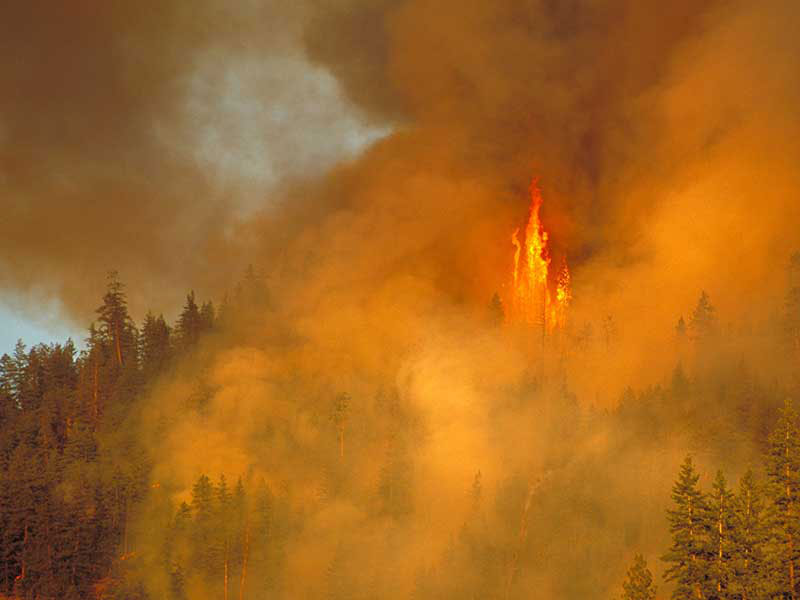
An unusually active season has boosted the prominence of Canadian wildfires for the general public and ETF providers alike.
In June, air quality warnings became a common feature of life in Canadian and American cities blanketed by smoke. With the typical late-summer peak wildfire period still to come, the Canadian Interagency Forest Fire Centre reports that almost 10 million hectares of land have already succumbed nationwide in 2023, a burn area more than double the annual total for any of the last 25 years.
According to a recent Bloomberg report, some of the affected area included vegetation from a B.C. forest set aside for carbon offsets, raising fears that projects meant to reduce carbon footprints could actually end up contributing to the level of greenhouse gas emissions pumped into the atmosphere. The owner of the B.C. project told Bloomberg that the fire had only affected 0.25% of its holdings, and that it operates a buffer pool to account for losses.
The B.C. project is typical of many in the voluntary market for carbon credits, where operators plant or maintain forests, measuring the greenhouse gas reduction associated with their activities. The emissions savings are then converted to credits for sale to anyone who wishes to reduce their own carbon footprint.
For Purpose Investments Inc., one of the few Canadian ETF providers to incorporate carbon offsetting into their product line, projects like these are critical for its carbon neutral offerings. Since late 2021, the firm has purchased credits on a weekly basis for investors who want to offset the emissions associated with its Bitcoin ETF.
While none of Purpose’s offsets have so far been affected by wildfires in Canada or elsewhere, Greg Taylor, the firm’s chief investment officer, said he is aware of the risk. He hopes that the recent spate of incidents will spur advances in the design of offset projects to reduce the chances of destruction.
“We want to have a positive impact, and as offsetting evolves, there are going to be learnings over time, and hopefully we will see progress and improvements,” Taylor said.
In the meantime, Purpose relies on third-party offset specialists to monitor and report on the climate projects underlying its own carbon credits. For its Bitcoin ETF, the firm works with California-based Patch not only to measure the carbon footprint of its cryptocurrency holdings, but also to vet and verify the associated matching offsets, while Swiss carbon finance consultancy South Pole performs a similar role for Purpose’s HANzero collaboration, which is listed on the London Stock Exchange.
Hussein Allidina, the managing director of TD Asset Management Inc.’s Global Carbon Credit Index ETF, said his fund is not exposed directly to the risk of wildfires or other natural disasters because of the firm’s decision to steer clear of the voluntary offset market.
Instead, TD opted to track the performance of carbon credits in highly regulated cap-and-trade systems such as those operated by the European Union and California, where larger polluters are forced to buy government-issued credits to match their actual emissions.
“When we first thought about launching this carbon fund in 2021, we had a conscious talk about the voluntary market, but it’s still not structured in a way that you know with a high degree of certainty that you are actually buying what you think you are buying,” he said. “The simple fact that I can buy a credit for $2 per ton and I can buy a similar credit for $20 per ton leads me to believe that there is something not quite right there yet.”
By contrast, the price for a credit representing one ton of carbon dioxide on the EU Emissions Trading System has fluctuated from 80 to 100 euros since the beginning of 2023 (CAD$115 to $145).
“But again, it’s early days and I think as that market is developed, it becomes more interesting,” Allidina added.
If wildfires persist at a heightened level over the longer term, he said they could have a more indirect impact on the compliance carbon market by bolstering the case for tighter restrictions and higher prices on emissions.
“I’m not an environmentalist and I’m not a meteorologist; I trade commodities,” Allidina said. “I don’t know what the truth is, but what I do believe is that the mere fact that we have these forest fires does force and raise some awareness around the climate.”
“Directionally, it’s clear that the world is moving and continues to move in a direction where pricing carbon is one of the ways that we are going to ultimately reduce our footprint,” he added.